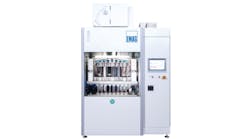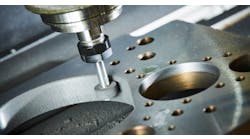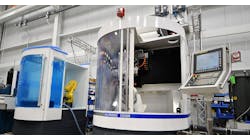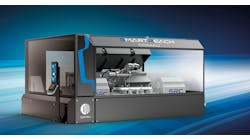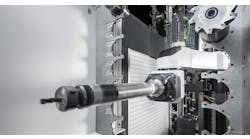More Improvement in US Machine Tool Orders
5-Axis Machining for Large Parts
A New Era in Vertical Machining
Redesigned HMC with New Tool Magazine
Turning is among the oldest manufacturing processes, having been developed in the Middle Ages and adapted in multiple ways over centuries. Turning is still used to produce components for nearly every industrial sector, but often it takes producers to the technical limits of their process technology, particularly with small and very small components. Tool wear, tool life, machining forces, and the heat affected zone became a limiting factor.
Now, laser experts with GFH GmbH have replaced a conventional turning tool with contactless laser that evaporates workpiece material with ultra-short laser pulses. This new turning technology has been integrated from the GFH into a specially designed production machine. The process-related technology disadvantage of the lower removal volume per unit compared to the cutting process is eliminated by the double-spindle concept.
GFH's GL.smart system, integrated with CAD/CAM capability, marks the next milestone in turning.
"Rotosymmetrical components are in the course of miniaturization even smaller and more sophisticated," according to Florian Lendner, CEO of GFH GmbH. “This is where conventional manufacturing technologies reach their limits, because the cutting forces, that act on the component and the tool size, make machining more difficult and even make it impossible with particularly sensitive geometries. This is especially true when materials are needed that are considered difficult to machine.”
Several years ago, GFH GmbH demonstrated the possibility of turning and grinding with lasers on its universal laser micromachining systems. However, the full potential of the new manufacturing technology could be only partially exploited: There were limitations, for example, in terms of the speed of rotation of the components, the efficient use of laser radiation and generally the complete workflow. These limitations have been eliminated with the new machine.
"After several years of intensive development work together with reference customers and supported by European research funding as part of the Horizon 2020 project, we can proudly present our new turning and grinding solution," Lendner reported. “It is available as a double spindle in short and/or long turning design, optionally with a rotating swivel unit as a counter spindle. This means there are no limits to the complexity of the components, and even end machining is possible.”
Rotationally symmetrical precision components — In addition to pure turning and grinding, the machine is able to perform drilling, cutting, and engraving - without any remodeling work. This makes the GL.smart an all-round option for rotationally symmetrical precision components.
A critical factor is the combination of high process speed with absolute precision. For this purpose, the air-bearing main spindle is accelerated a torque drive in a position-controlled manner up to 3,500 rpm within 0.4 seconds. Radial and axial concentricity in the nanometer range enables production with grinding tolerances. A force-controlled, tension collet system with wobble correction and automatic bar feed represents the interface to the component.
Measuring 2,212 x 1,026 x 2,320 mm (L x W x H), the GL.smart offers productivity with excess space requirement. In addition to its compact design, its black glass housing offers full protection against laser radiation, and a safe shielding from X-rays that have been proven by test methods. By using high-power lasers in combination with beam splitting, simultaneous processing on two stations is possible, which means double output.
"On request, the machine also can be equipped with a bar feeder as a loading unit. In combination with integrated component handling by means of robots we offer a fully automated solution for the 24/7 production of parts without restriction," Lendner explained. In addition, SPC and N.O.K. parts are kept separate and can be taken via robot without interruption of production.
From medical devices to watches —Applications for the new GL.smart are diverse, ranging from production of micro tools for medical use (tweezers, micro blades or implants) to manufacturing so-called pivots, installed in clocks and watches. The advantages of laser processing include attractive production times, which can be achieved thanks to the roughing and finishing process using ultra-short pulse lasers.
In a first step, as much material as possible is removed by roughing with a high energy input. For finishing, the final quality is achieved in the finishing process with less energy. On the other hand, almost any material can be used for non-contact, wear-free machining of even the smallest components.
Laser turning allows unusually high accuracy, particularly in manufacturing and processing of precision parts, so that other, more complex processes (e.g., conventional grinding or roller burnishing) can be saved, Lendner said. “Thanks to the non-contact removal, the workpiece remains free of force and deformation during the entire machining time. This means that there is no loss of accuracy even with very thin and delicate components.” In this way, also parts with a large length can be easily machined.
Control software based on process experience — The systems also be freely programmed and controlled using the GL.control software, also developed by GFH, based on software process know-how from more than twenty years.
"Thanks to our own software development and daily use in-house, GL.control is in a constant process of improvement and further development," Lendner said. "The intuitive and simple operating concept, the integration of the CAD-CAM functions as well as the complete integration of all subsystems, such as the laser, scanner, or drilling optics make it easier for the user to operate the machine true to the motto 'only one software to control everything'."
The PLC of GL.smart, is the fastest CNC control on the market and has been specially designed for laser processing. This control offers real-time access for the laser control, so that the laser can be switched on with an accuracy of 40 nm at full dynamic of the axes.

